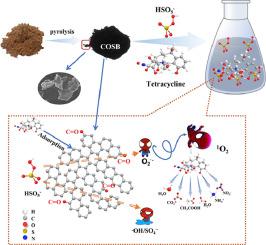Journal of the Taiwan Institute of Chemical Engineers ( IF 5.7 ) Pub Date : 2023-03-17 , DOI: 10.1016/j.jtice.2023.104815 Rui Zhang , Zhi-Xia Zhang , Fang Wang , Dezhi Chen

|
Background
Biochar has attracted much attention in peroxymonosulfate (PMS) activation for the elimination of organic pollutants in water. However, the factor to determine the catalytic efficiency of biochar and the evolution of reactive oxygen species (ROS) remain equivocal and elusive.
Method & result
In this study, Camellia oleifera shell-derived biochar (COSB) was prepared by one-step pyrolysis. The pyrolysis temperature could tune the catalytic performance of COSB. Owing to more C=O groups and defects, the COSB-1000 prepared at 1000 °C showed the optimal activity in PMS activation. In the presence of 0.4 g∙L−1 of COSB-1000 and 1.0 g∙L−1 PMS, 91.57% of tetracycline hydrochloride (TC, 20 mg·L−1) was degraded within 105 min. In addition, the COSB-1000/PMS system demonstrated good anti-interference ability and a wide pH applicability from 3.0 to 11.0. Quenching experiment and electron spin resonance (EPR) spectroscopy suggested that the non-radical oxidation process dominated by the generated , which was converted from , play the vital role in TC degradation by the COSB-1000/PMS system. Furthermore, four possible degradation pathways of TC in the COSB-1000/PMS system are proposed by the mass spectroscopy, and the growth-inhibition of Escherichia coli showed that the degradation intermediates were low toxicity.
Significant findings
The results here shed light on the generation of by biochar and deepen the insight for the environmentally-friendly catalysts derived from biomass in activating PMS for wastewater treatment.
中文翻译:

生物炭/过一硫酸盐体系中单线态氧主导的非自由基氧化高效降解四环素盐酸盐:表面位点和催化机制
背景
生物炭在用于消除水中有机污染物的过氧单硫酸盐(PMS)活化方面引起了广泛关注。然而,决定生物炭催化效率的因素和活性氧 (ROS) 的演变仍然模棱两可且难以捉摸。
方法与结果
在这项研究中,通过一步热解法制备了油茶壳衍生生物炭 (COSB)。热解温度可以调节 COSB 的催化性能。由于更多的 C=O 基团和缺陷,在 1000 °C 下制备的 COSB-1000 在 PMS 激活中显示出最佳活性。在 0.4 g∙L -1 COSB-1000 和 1.0 g∙L -1 PMS存在下,91.57% 的四环素盐酸盐(TC,20 mg·L -1)在 105 分钟内被降解。此外,COSB-1000/PMS系统表现出良好的抗干扰能力和3.0至11.0的广泛pH适用性。淬火实验和电子自旋共振 (EPR) 光谱表明,非自由基氧化过程主要由生成的, 这是从, 在 COSB-1000/PMS 系统的 TC 降解中起着至关重要的作用。此外,通过质谱分析提出了TC在COSB-1000/PMS系统中的四种可能的降解途径,大肠杆菌的生长抑制表明降解中间体是低毒的。
重要发现
这里的结果揭示了通过 biochar 并加深对源自生物质的环保催化剂在激活 PMS 以进行废水处理方面的认识。



























 京公网安备 11010802027423号
京公网安备 11010802027423号